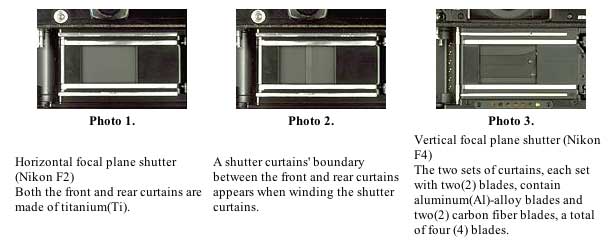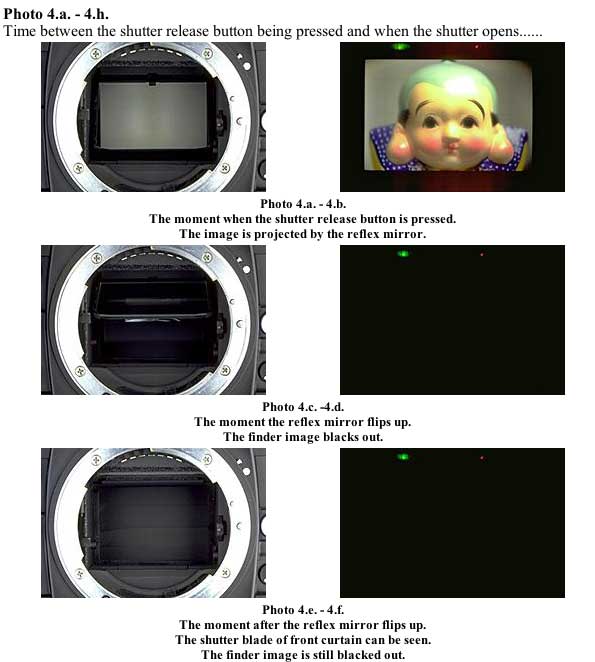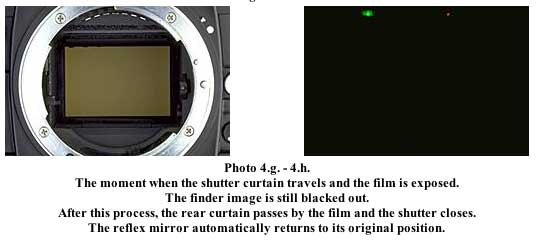CHAPTER 4
Shutter
1. What is a shutter?
A camera shutter is like a tiny door that opens up for a specified length of time to allow light to hit the film.
Eye color depends on the color of the iris. If the surface of the iris has a low pigment density, eyes are blue. If pigment
density is high, eyes will be brown or black.
Early cameras (photo provided by the JCII Camera Museum) had a lid to cover the front of the lens. To take a picture,
the photographer removed the lid, counted a certain number of seconds, then replaced the lid.
Though awkward, this timing method was necessary because film in that period had a very low sensitivity and it required
several seconds for exposure in the daylight.
This method is still used when taking long-time exposure pictures of the starts.
Today, however, film sensitivity is very high and this manual exposure method has become obsolete, if not quaint.
Modern shutters can be set with astounding accuracy to remain open anywhere from a few thousandths of a second to a few full seconds.
There are two(2) major types of shutters used in modern cameras, the lens shutter and the focal plane shutter.
A lens shutter has the shutter mechanism close to the lens (some also work as the aperture mechanism) and is used
mostly for large-format and medium-format cameras, as well as compact cameras.
Usually, there is a light-screening mechanism — a shutter blade, for example — in the front or back of the lens.
The opening and closing of this blade controls exposure time.
Because the shutter is built into the lens, another light-screening object is necessary in order to shield the film
when making the lens interchangeable.
Today, most 35mm(135) format SLR cameras with interchangeable lenses do not use this lens shutter mechanism.
(One-time use cameras use lens shutters, but their speed is fixed around 1/100 sec.)
Modern 35mm(135) format SLR cameras and IX 240 SLR cameras use focal plane shutters.
It's a basic fact of photography that you have to press the shutter release button to take a picture.
The word "shutter" as it applies to cameras has the same meaning as the shutters you see covering windows
or store fronts; therefore, it's easy to guess what purpose a camera shutter serves.
KUMON, Yasushi
1.1. Focal-plane shutter mechanism
The focal plane is the focusing surface, which means that the shutter is directly in front of the film. Because
it's in this position, there is no real need to screen light when changing lenses.
A conventional focal plane shutter consists of two blades or two sets of blades that block light.
Exposure time is adjusted by making these blades pass by the film at different times.
The first blade is called the front curtain; the second is called the rear curtain.
The object you see when you open the back cover of an SLR camera is the shutter curtain. Do not touch it !
One type of shutter curtain, called a horizontal-travel focal plane shutter, moves sideways.
The conventional horizontal type, called a drum-type shutter, is usually made of silk cloth or metal
(stainless steel, titanium (Ti), etc.).
A shutter curtain that travels vertically is called a vertical-travel focal plane shutter.
On occasion, you might find a drum-type shutter that travels vertically; but most modern SLR cameras have two(2) curtains.
These are usually referred to as square shutters
This square shutter is composed of a front and rear curtain, each made of long, thin blades in a layered configuration.
Think of an elevator door, and you have an idea how they operate.

Another thing to consider is that with a conventional SLR camera, it is impossible to confirm the shooting image when the shutter is open (in other words, the moment the picture is actually taken). When the shutter opens, the reflex mirror flips up to expose the film, which means it requires time to return to its original position. The amount of time needed for this is called quick return.
That is why the viewfinder "winks" when shooting with an SLR camera.
If you bear these things in mind, you might be able to take more "decisive moments", like Henri Cartier Bresson.
Pressing the shutter release button causes the shutter to open and close. It is during this moment when light hits
the film that the film is exposed and a picture is taken.
It is the nature of photography that we sometimes see an event, a person or some other subject and think, "I'd like
to take a picture of that right now."
But sometimes the timing seems off or inopportune. This begs the question, "Is there ever a decisive moment during
photography, one best for taking any given picture ?"
When answering this question, keep in mind some of the disadvantages of SLR cameras.
First, the system for viewing objects is a bit complicated. The image in the finder is actually the image from the
reflex mirror, which is built into the SLR camera.
This means when the shutter release button is pressed, the mirror pops up and the shutter's front curtain is set
in motion. This process, from start to finish, takes about 1/20 (0.05 sec.), depending on the camera.
Additionally, you must consider the amount of time that passes between the moment you decide to take a photo
and the moment you actually press the shutter release button.
The trick is, then, to press the shutter release button before "the decisive moment." A keen sense of
anticipation, therefore, is the key to taking more rewarding photographs.
To be more exact, it requires few tenths of a second before a person decides to press the shutter
button until the finger actually presses the button.
Therefore, you should press the button a bit earlier.
Another thing to consider is that with a conventional SLR camera, it is impossible to confirm the
shooting image when the shutter is open (in other words, the moment the picture is actually taken).
When the shutter opens, the reflex mirror flips up to expose the film, which means it requires
time to return to its original position. The amount of time needed for this is called quick return.
That is why the viewfinder "winks" when shooting with an SLR camera.
If you bear these things in mind, you might be able to take more "decisive moments", like Henri Cartier Bresson.





